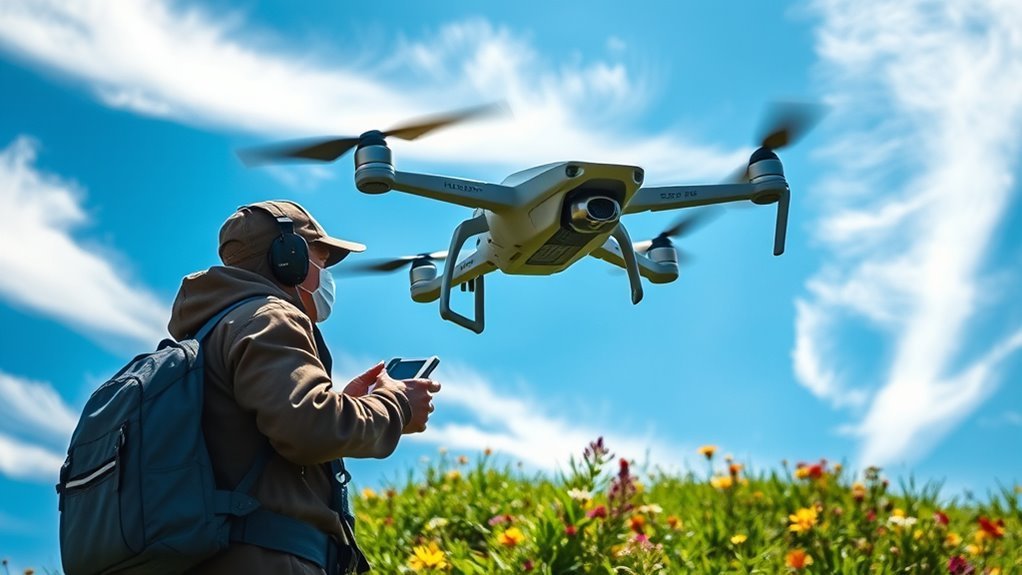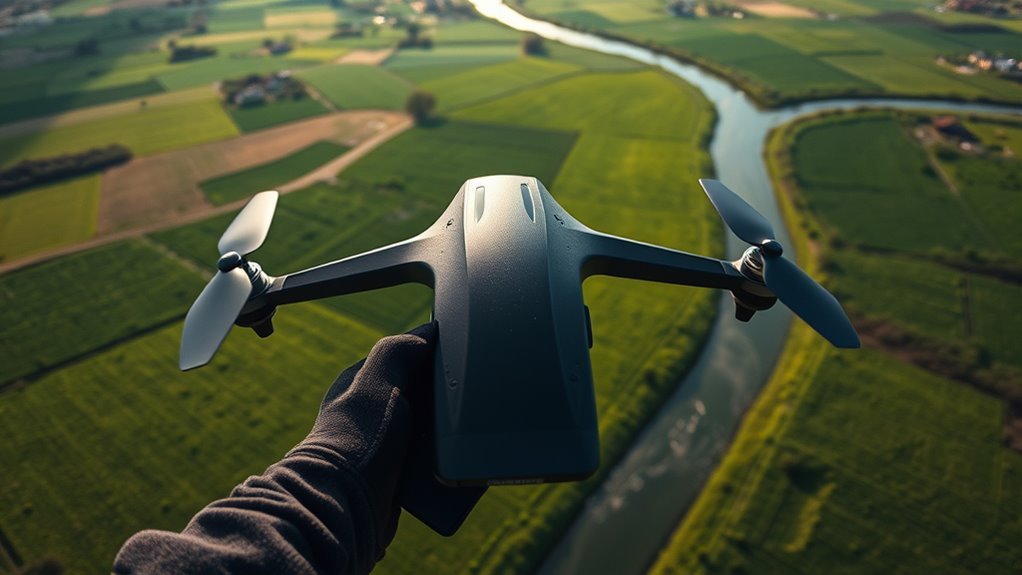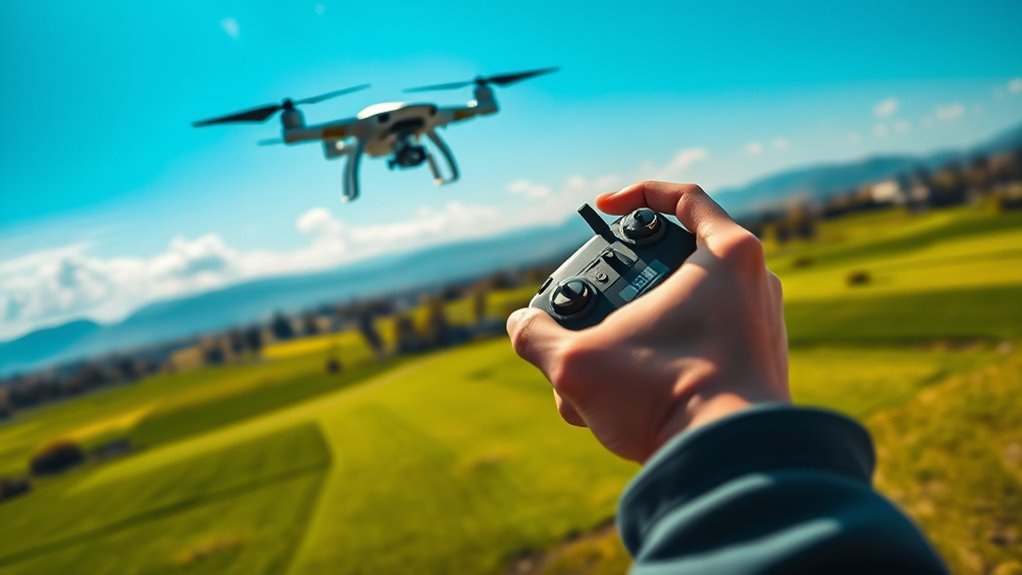To master your Sky Rider Drone, start by familiarizing yourself with its components and assembly. Confirm the battery is fully charged and conduct a pre-flight checklist for safety. Learn the controls: the left stick manages altitude and yaw, while the right controls pitch and roll. Practice takeoff on a clear surface and focus on smooth landings. Experiment with basic maneuvers to enhance your flying skills. There’s much more to explore as you refine your aerial photography techniques.
Getting to Know Your Sky Rider Drone

When you first unpack your Sky Rider Drone, it’s vital to familiarize yourself with its components and features to guarantee peak performance. Start by examining the drone’s structure, including the rotors and landing gear, ensuring they’re secure. Pay particular attention to the battery life indicator, as this will determine your flight duration. The Sky Rider boasts advanced drone features such as GPS positioning and an HD camera, which enhance your flying experience and provide creative opportunities. Understanding these functionalities will empower you to make the most of your device. Additionally, the advanced battery optimization techniques will help you manage power consumption effectively, ensuring longer flights. Finally, always check the battery’s charge before every flight; a well-maintained battery is essential for ideal performance and extended aerial freedom. Additionally, proper battery storage practices can significantly influence its longevity and reliability over time.
Preparing for Your First Flight

Before you take to the skies, it’s vital to assemble your Sky Rider Drone correctly. Make certain you follow the drone assembly steps meticulously and complete the pre-flight checklist items to guarantee peak performance. These preparations are essential for a successful first flight and to avoid potential issues. Additionally, understanding the drone’s control range will help you plan your flight path effectively. Knowing the legal regulations governing flight distance is crucial to ensure compliance and safety.
Drone Assembly Steps
As you gear up for your first flight with the Sky Rider Drone, assembling the components correctly is essential to guarantee peak performance and safety. Start by carefully reviewing the assembly guide to familiarize yourself with the drone parts. Lay out all components, including the frame, propellers, and battery, confirming nothing’s missing. Attach the arms securely to the main body, followed by the propellers, using the correct orientation indicated in the guide. Connect the battery, making sure it’s firmly in place. Double-check all connections and verify there are no loose wires. Finally, inspect the drone visually for any assembly errors. This meticulous approach not only enhances your drone’s functionality but also assures a seamless flying experience.
Pre-Flight Checklist Items
Following the assembly of your Sky Rider Drone, it’s essential to conduct a thorough pre-flight checklist to guarantee everything is in ideal condition for your inaugural ascent. Start with a pre-flight safety inspection; verify the propellers are securely attached and free of damage. Next, perform a battery check—confirm that the battery is fully charged and properly connected. Check the remote control for signal strength and responsiveness, and ensure that all settings are configured correctly. Inspect the area for obstacles and confirm you’re in a safe, open space for takeoff. Finally, familiarize yourself with the drone’s features and controls. Completing this checklist will enhance your confidence and guarantee a smooth, enjoyable flying experience.
Understanding the Controls

To effectively operate the Sky Rider Drone, you need to understand the control stick functions and their specific responses. Each control stick plays a critical role in maneuverability, while the safety features are designed to protect both the drone and its surroundings. Familiarizing yourself with these elements is essential for a smooth flying experience. Additionally, implementing advanced data encryption can enhance the security of your drone operations, ensuring that sensitive data remains protected during flights. Understanding the importance of flight duration can also help you plan your sessions effectively, maximizing your time in the air.
Control Stick Functions
Understanding the control stick functions is essential for effectively operating the Sky Rider Drone. The control stick is your primary interface, allowing you to achieve flight precision. The left stick typically controls altitude and yaw, enabling you to ascend, descend, and rotate. The right stick manages pitch and roll, which helps in maneuvering the drone forward, backward, and sideways.
Safety Features Overview
While you’re mastering the controls of the Sky Rider Drone, it’s crucial to familiarize yourself with its safety features, which are designed to protect both the drone and its surroundings. Key among these is the collision avoidance system, which uses sensors to detect obstacles and automatically alter the drone’s flight path, minimizing crash risks. This feature allows you to explore your environment with greater confidence and freedom. Additionally, the emergency landing function provides a safety net; should you encounter a malfunction or loss of control, it enables the drone to return to the ground safely. Understanding these mechanisms will not only enhance your flying experience but also promote responsible operation, safeguarding your investment and the surrounding area.
Taking Off and Landing Safely
Ensuring a safe takeoff and landing is critical for successful drone operation, as these phases are often the most vulnerable to accidents. To achieve this, familiarize yourself with effective takeoff techniques. Start by selecting a clear, level surface free from obstacles. Use GPS features to help stabilize your drone during ascent. When it’s time to land, approach slowly and steadily. Deploy landing pads to protect your drone from debris and uneven ground, ensuring a smooth touchdown. Monitor wind conditions and adjust your descent accordingly. Always check for surrounding people or animals before landing. By mastering these safety measures, you’ll enhance your flying experience and maintain the freedom that comes with piloting the Sky Rider Drone. Additionally, understanding battery life can significantly improve your flight planning, ensuring you have enough power for safe landings. The advanced drone sensors in modern models, like the Autel Robotics EVO Lite+, also contribute to smoother flights and safer landings.
Mastering Basic Maneuvers
Mastering basic maneuvers is essential for any Sky Rider Drone pilot, as it forms the foundation for advanced flying techniques. You’ll need to focus on two primary skills: hovering techniques and turning maneuvers.
| Maneuver Type | Description |
|---|---|
| Hovering Techniques | Maintain a stable position in the air, adjusting throttle for balance. |
| Turning Maneuvers | Use the yaw controls for smooth, coordinated turns without losing altitude. |
| Forward Flight | Shift weight and throttle to gain speed and altitude. |
| Reverse Flight | Gradually pull back on the throttle while directing backward. |
Practicing these maneuvers will enhance your control and boost your confidence. As you refine these skills, you’ll gain the freedom to explore more complex flying techniques. It’s important to consider payload weight distribution as it can significantly affect flight stability and control. Additionally, understanding battery performance can help you plan your flights effectively and avoid unexpected returns to base.
Tips for Capturing Stunning Aerial Footage
Once you’ve honed your basic maneuvers, capturing stunning aerial footage becomes the next exciting challenge. To elevate your shots, master aerial composition techniques like the rule of thirds, leading lines, and framing. These principles guide the viewer’s eye and create dynamic visuals. Pay close attention to lighting conditions; the golden hour—shortly after sunrise or before sunset—offers soft, diffused light that enhances colors and reduces harsh shadows. Use your drone’s altitude and angles creatively to capture unique perspectives and depth. Experiment with different heights and movements to add dynamism to your footage. Additionally, utilizing AI tools can provide real-time insights for optimizing your filming conditions. Finally, keep your drone steady during recording; smooth shifts and controlled movements guarantee professional-looking results that truly showcase the freedom of flight. Additionally, ensure you are aware of federal aviation regulations to avoid potential penalties and operate responsibly.
Troubleshooting Common Issues
While flying your Sky Rider drone can be exhilarating, you might encounter common issues that can impede your experience. One prevalent problem is battery issues. If your drone’s flight time seems shorter than expected, verify the battery is fully charged and check for any signs of wear. Consider replacing it if it doesn’t hold a charge well.
Another frequent challenge involves connectivity problems. If you’re experiencing lag or disconnection from the controller, make certain you’re within range and that there are no obstructions. Resetting the drone and reconnecting can often resolve these issues. Regularly updating the firmware can also enhance stability, assuring you can enjoy the freedom of flight without interruptions.
Frequently Asked Questions
What Is the Maximum Flight Time of the Sky Rider Drone?
“Time flies when you’re having fun.” The Sky Rider Drone typically offers a flight duration of up to 10-15 minutes, depending on battery capacity. Understanding this helps maximize your aerial adventures and capture stunning visuals.
Can I Fly My Drone in Rainy Weather?
Flying your drone in rainy conditions isn’t advisable, as moisture can negatively impact drone performance. It can lead to malfunctioning controls and reduce battery life, compromising your flying experience and safety. Always prioritize favorable weather.
How Do I Register My Drone for Legal Flying?
To fly legally, you’ve gotta complete drone registration with the FAA. It’s simple; just provide your drone’s details online. Familiarize yourself with legal requirements to guarantee smooth flights without hassle or fines. Enjoy your freedom!
What Accessories Can Enhance My Sky Rider Drone Experience?
To enhance your flying experience, consider drone accessories like extended battery packs for longer flights, high-definition cameras for stunning visuals, and protective cases for safeguarding your equipment. These enhancements elevate your drone experience considerably.
Is There a Warranty or Return Policy for the Sky Rider Drone?
You might think warranties are always straightforward, but the Sky Rider Drone offers specific warranty details. For returns, follow the outlined return process meticulously to guarantee a smooth experience without unexpected complications.

